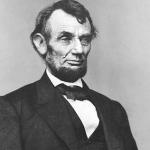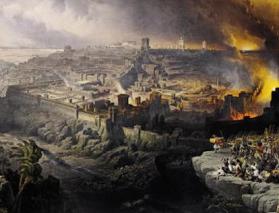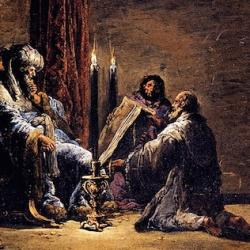After the northern tribes abandon the house of David (2 Chronicles 10), Rehoboam settles in Jerusalem (2 Chronicles 11:5). He builds cities for defense and for storage (11:5-12), receives the Levites and priests who flee from idolatrous Israel (11:13-17), marries and has children (11:18-23). The chapter moves from land to temple to royal house.
It also has hints of a chiastic structure. Verses 5, 11 refer to fortress cities and food stores, and verses 22-23 return to this theme, noting that Rehoboam distributed “fortress cities” and “food in abundance” to his sons. Between these bookends are some surprising chiastic correlations:
A. Fortress cities and food storage, 11:5-12
B. Levites, priests, and others who seek Yahweh, 11:13-16
C. Kingdom strengthened, walk in the way of David for three years, 11:17
B’. Wives, concubines, and sons, 11:18-21
A’. Fortress cities and food storage to sons, 11:21-22
Rehoboam’s building projects for a double ring of protection around Jerusalem, stretching into Philistine territory in the west (Gath, v. 8). At the end of the chapter, Rehoboam appoints his son Abijah as his successor, and “wisely” distributes power and goods to his other sons. In this way, he hopes to protect the peace of his kingdom, to head of fraternal strife after his death.
The notice that Rehoboam walked in the way of David makes sense as the center of the text. For a period at least, he is a good king. Verse 17 also picks up the notion of “strength” from the beginning and end of the section (11:11; 12:1).
B informs us of Jeroboam’s satyrs and golden calves (11:15), and his decision to exclude Levites and Aaron priests from service. They head south to Judah, and those who want to seek Yahweh follow them.
With the combination of Judah, Benjamin, and Levi, the southern kingdom replicates the basic structure of the ideal Israel of the genealogies (1 Chronicles 1-9; see William Johnstone, 1 & 2 Chronicles). Judah begins the genealogies, Benjamin comes at the end, and Levites are at the center. Judah is much-reduced, but the skeleton of the original Israel is still apparent.
The surprise in the structure is the parallel of Levites and priests with members of Rehoboam’s household. At a certain level of abstraction, the sense of the parallel is obvious: As Yahweh has His own house with His own Levitical servants, so Rehoboam the king has his household.
Perhaps, though, the connection is stronger: Priests and Levites are seen not only as members of Yahweh’s household but as part of the king’s entourage. These migrants from the north, after all, “strengthen” the kingdom (11:16).
Or, more speculatively, perhaps there is a husband-wife or father-son relationship between king and Levites. The king is the Adam of Jerusalem, and the Levites are his Eve-like helpers. The king is father-Adam and the Levites are conceptually seen among his sons.
The Chronicler doesn’t criticize Rehoboam’s polygamy directly (18 wives, 60 concubines; 11:21) but there are hints of disapproval. The named wives are all relatives, cousins of one variety or another. This endogamy resembles the practices of Egypt, and is perhaps a hint that Rehoboam is inverting the exodus even before Shishak shows up to plunder Jerusalem.
Chapter 11 ends with the comment that Rehoboam “asked” (sha’al). The term is more pregnant than it might appear. A king with 60 concubines is clearly making a lot of alliances; in asking for wives, he’s seeking protection from potential rivals or adversaries. But protection doesn’t lie in that direction. Good kings sha’al God (2 Chronicles 1:7, 11).
Besides, the verb links back to Israel’s first king, Sha’ul, who sought help from a medium rather than from God (1 Chronicles 10:13-14). It’s not entirely a surprise when we learn (in 12:2) that Rehoboam commits a sacrilege, a ma’al, the first king to be charged with this crime since Saul (this is the first use of this key term since 1 Chronicles 10).
If we ignore the chapter break between 11 and 12, we move immediately from Rehoboam “asking” for wives to Rehoboam forsaking the Torah and committing a ma’al (12:1-2). Surely the juxtaposition hints at cause-and-effect.
Finally, as Johnstone has suggested, Rehoboam’s geopolitical play might have a role in Shishak’s invasion of Judah. It’s possible that Shishak was alarmed that his neighbor to the north was building alliances with other kings, To forestall the creation of a block of powers, he invades and weakens Judah.
In short, Rehoboam’s efforts to strengthen his kingdom by “asking” wives backfires: It makes his kingdom weaker.












